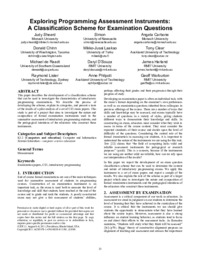Exploring programming assessment instrumentsa classification scheme for examination questions
Judy Sheard, Simon, Angela Carbone, Donald Chinn, Mikko-Jussi Laakso, Tony Clear, Michael de Raadt, Daryl J. D'Souza, James Harland, Raymond Lister, Anne Philpott, Geoff Warburton
Publikationsdatum:
Zu finden in: ICER 2011 (Seite 33 bis 38), 2011
|
 |
 Diese Seite wurde seit 5 Jahren inhaltlich nicht mehr aktualisiert.
Unter Umständen ist sie nicht mehr aktuell.
Diese Seite wurde seit 5 Jahren inhaltlich nicht mehr aktualisiert.
Unter Umständen ist sie nicht mehr aktuell.
 Zusammenfassungen
Zusammenfassungen
This paper describes the development of a classification scheme that can be used to investigate the characteristics of introductory programming examinations. We describe the process of developing the scheme, explain its categories, and present a taste of the results of a pilot analysis of a set of CS1 exam papers. This study is part of a project that aims to investigate the nature and composition of formal examination instruments used in the summative assessment of introductory programming students, and the pedagogical intentions of the educators who construct these instruments.
 Dieses Konferenz-Paper erwähnt ...
Dieses Konferenz-Paper erwähnt ...
 Zitationsgraph
Zitationsgraph
 Zitationsgraph (Beta-Test mit vis.js)
Zitationsgraph (Beta-Test mit vis.js)
 2 Erwähnungen
2 Erwähnungen 
- Koli Calling 2015 - Proceedings of the 15th Koli Calling Conference on Computing Education Research, Koli, Finland, November 19-22, 2015 (Päivi Kinnunen, Judy Sheard) (2015)
- Revisiting rainfall to explore exam questions and performance on CS1 (Antti-Jussi Lakanen, Vesa Lappalainen, Ville Isomöttönen) (2015)


- Revisiting rainfall to explore exam questions and performance on CS1 (Antti-Jussi Lakanen, Vesa Lappalainen, Ville Isomöttönen) (2015)
- ICER 2019 - Proceedings of the 2019 ACM Conference on International Computing Education Research, ICER 2019, Toronto, ON, Canada, August 12-14, 2019 (Robert McCartney, Andrew Petersen, Anthony V. Robins, Adon Moskal) (2019)
- Computing Education Theories - What Are They and How Are They Used? (Lauri Malmi, Judy Sheard, Päivi Kinnunen, Simon, Jane Sinclair) (2019)


- Computing Education Theories - What Are They and How Are They Used? (Lauri Malmi, Judy Sheard, Päivi Kinnunen, Simon, Jane Sinclair) (2019)
 Anderswo finden
Anderswo finden
 Volltext dieses Dokuments
Volltext dieses Dokuments
 |  Exploring programming assessment instruments: Fulltext at the ACM Digital Library ( Exploring programming assessment instruments: Fulltext at the ACM Digital Library ( : :  , 99 kByte; , 99 kByte;  : :  Link unterbrochen? Letzte Überprüfung: 2020-11-28 Letzte erfolgreiche Überprüfung: 2020-08-28) Link unterbrochen? Letzte Überprüfung: 2020-11-28 Letzte erfolgreiche Überprüfung: 2020-08-28) |
 Anderswo suchen
Anderswo suchen 
 Beat und dieses Konferenz-Paper
Beat und dieses Konferenz-Paper
Beat hat Dieses Konferenz-Paper während seiner Zeit am Institut für Medien und Schule (IMS) ins Biblionetz aufgenommen. Beat besitzt kein physisches, aber ein digitales Exemplar. Eine digitale Version ist auf dem Internet verfügbar (s.o.). Aufgrund der wenigen Einträge im Biblionetz scheint er es nicht wirklich gelesen zu haben. Es gibt bisher auch nur wenige Objekte im Biblionetz, die dieses Werk zitieren.











 Biblionetz-History
Biblionetz-History